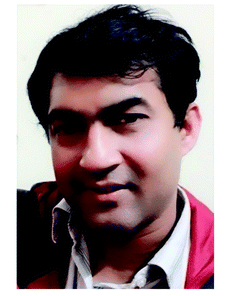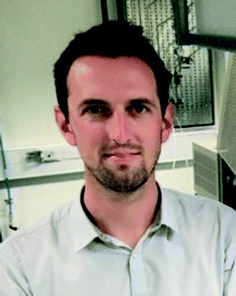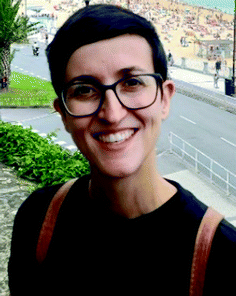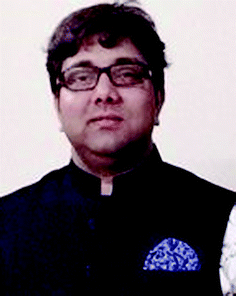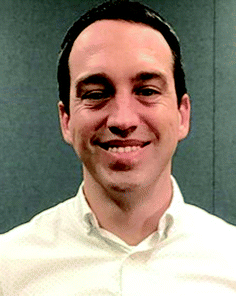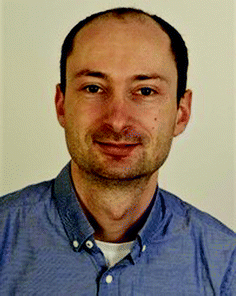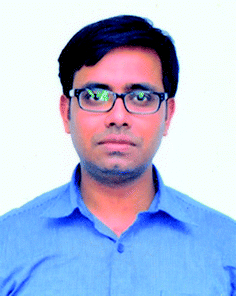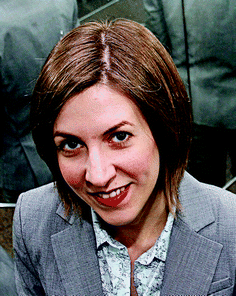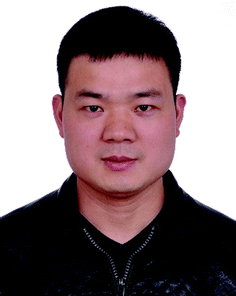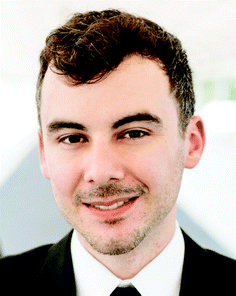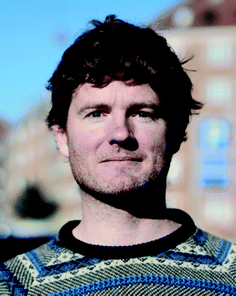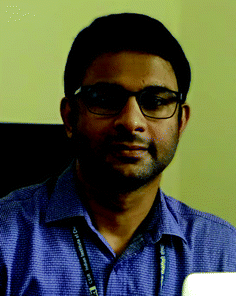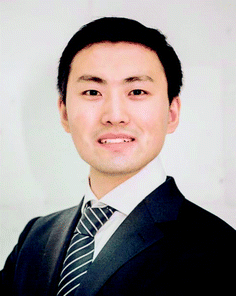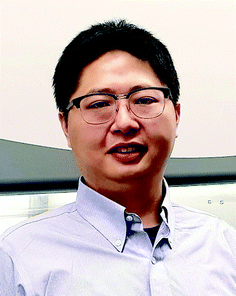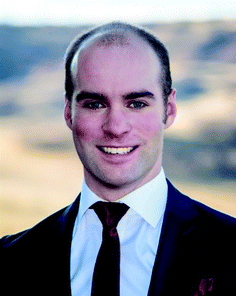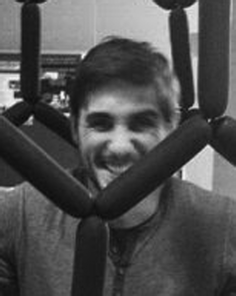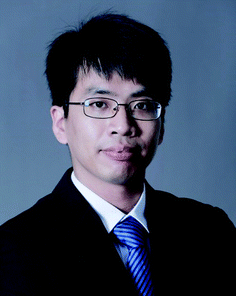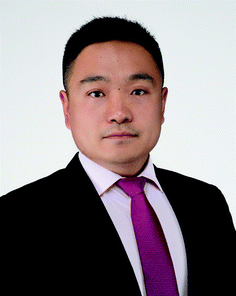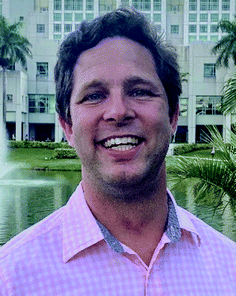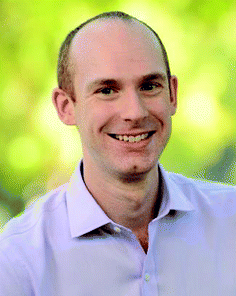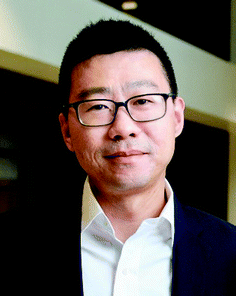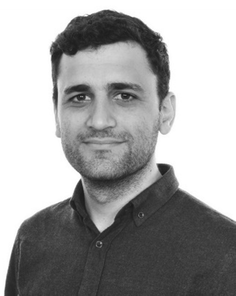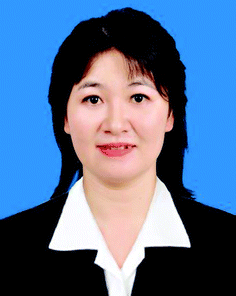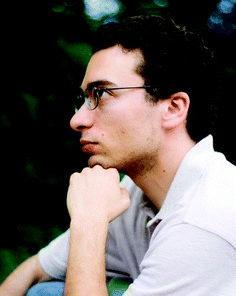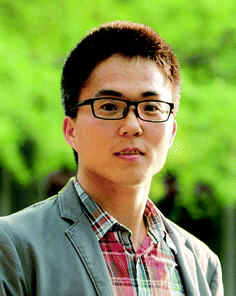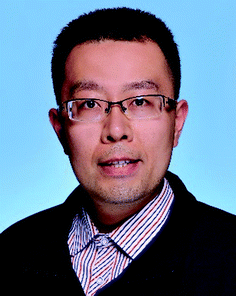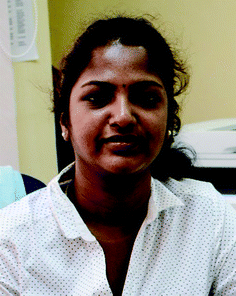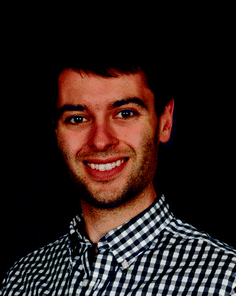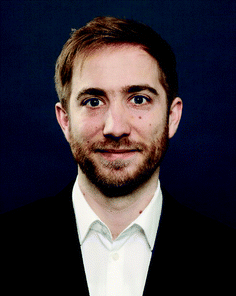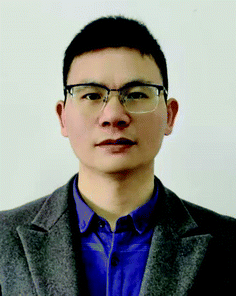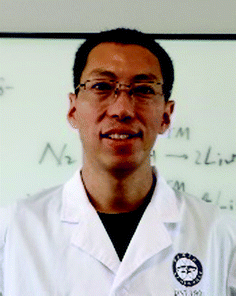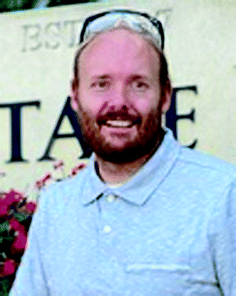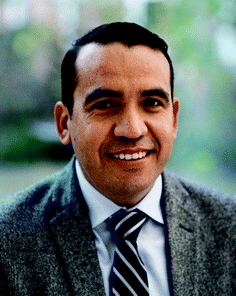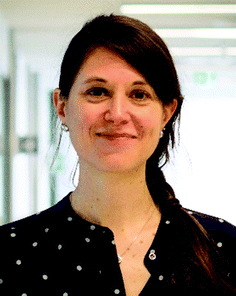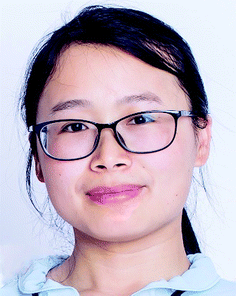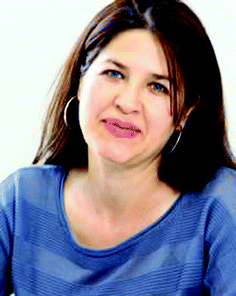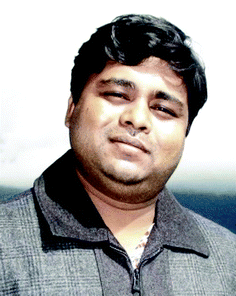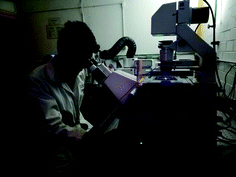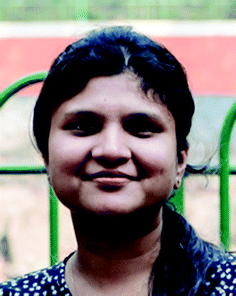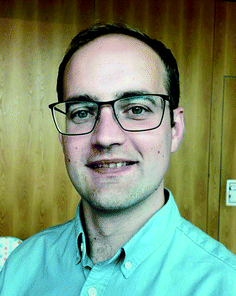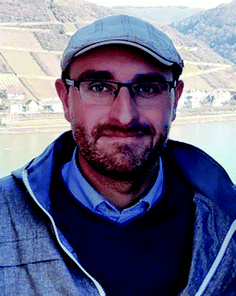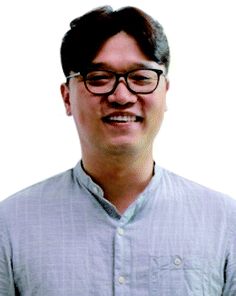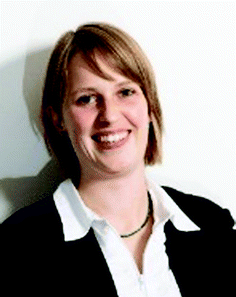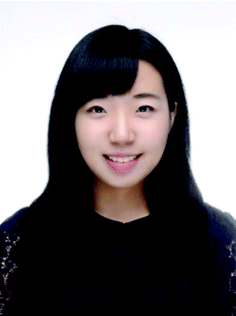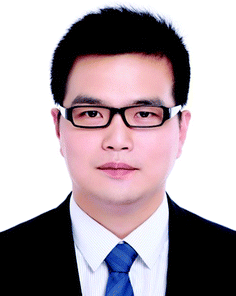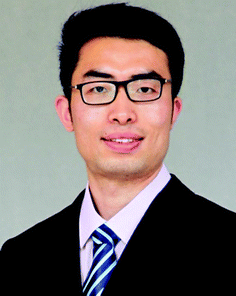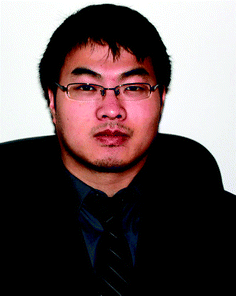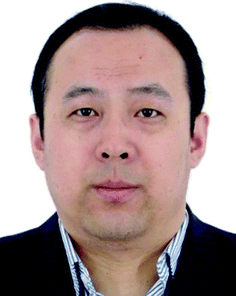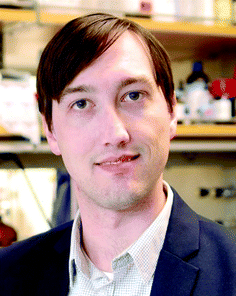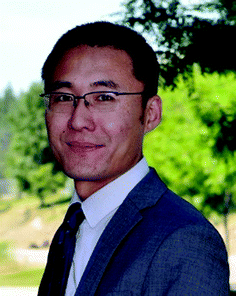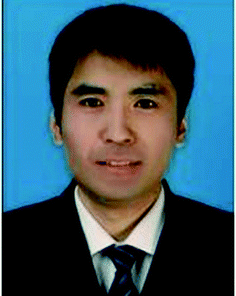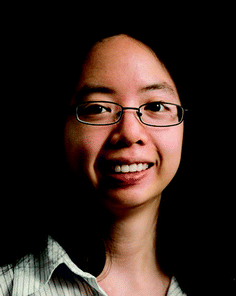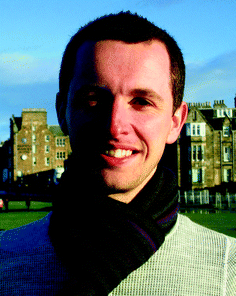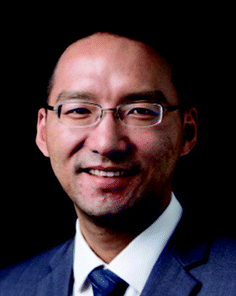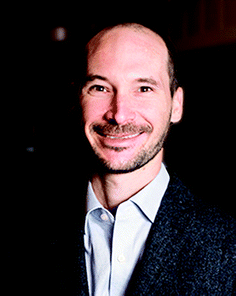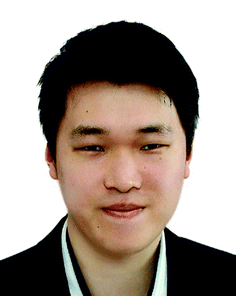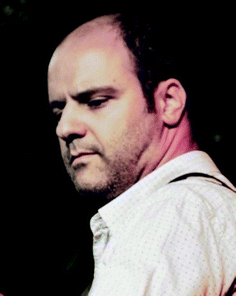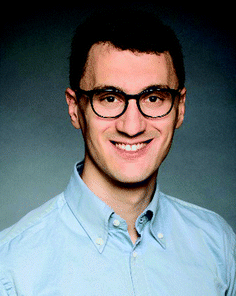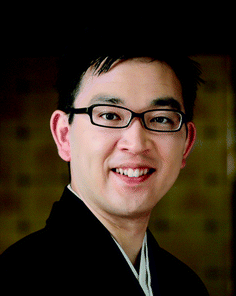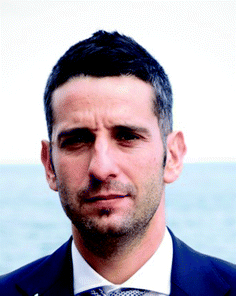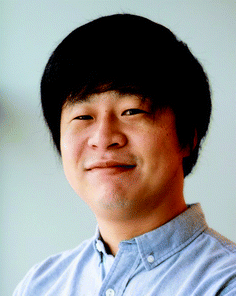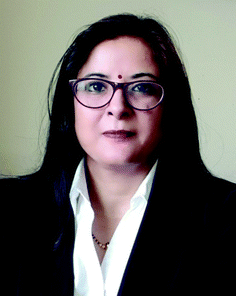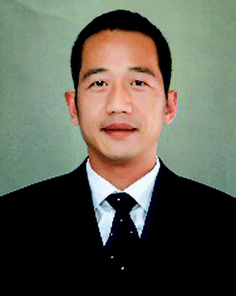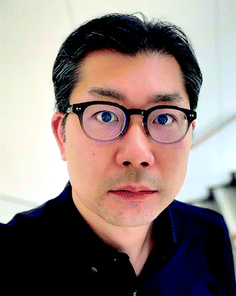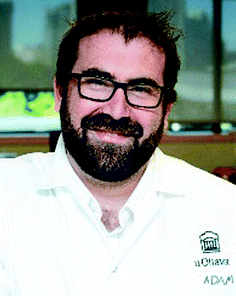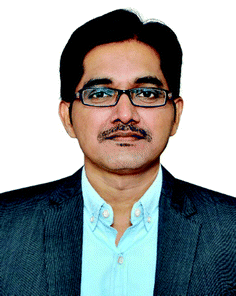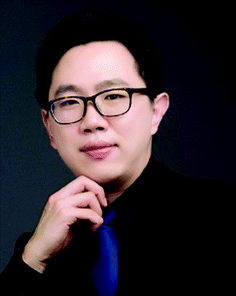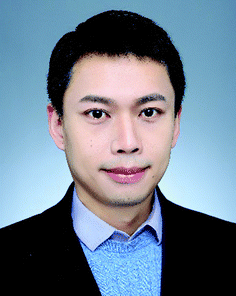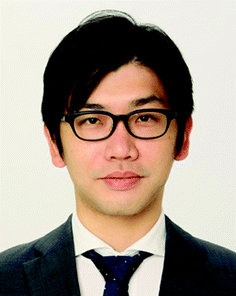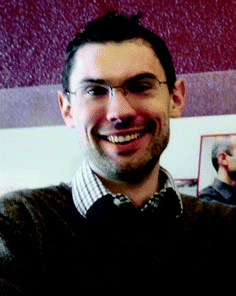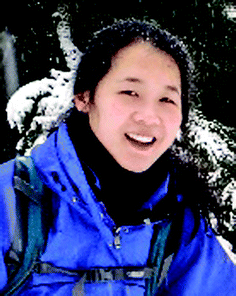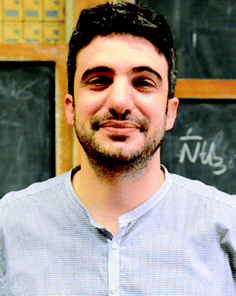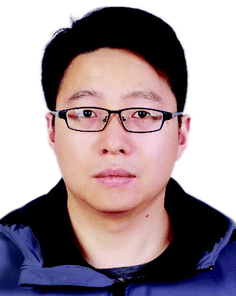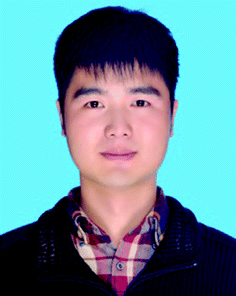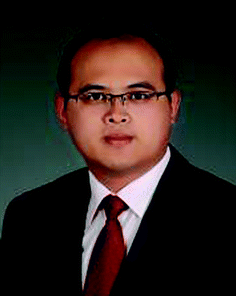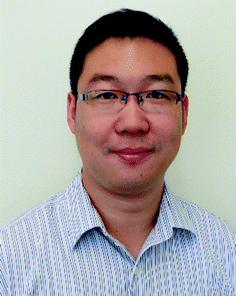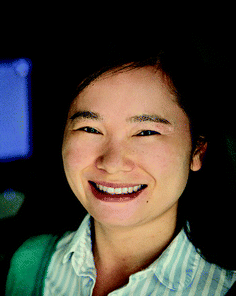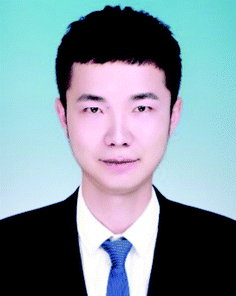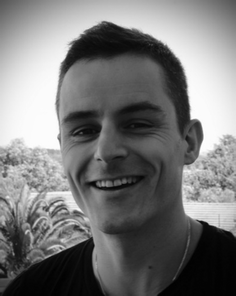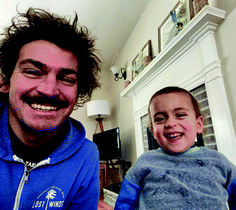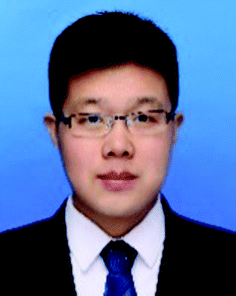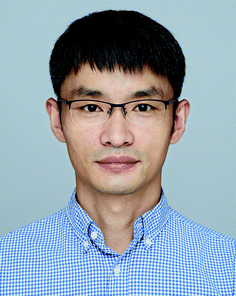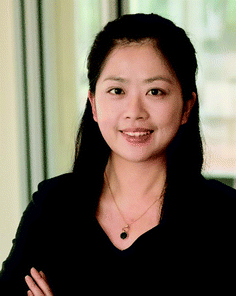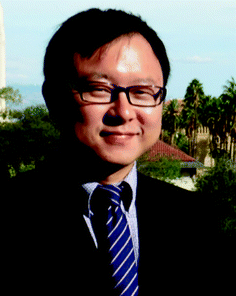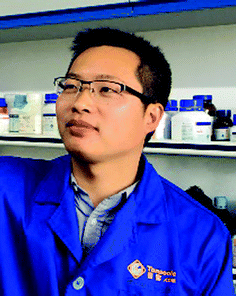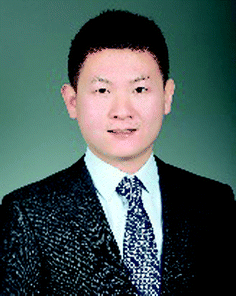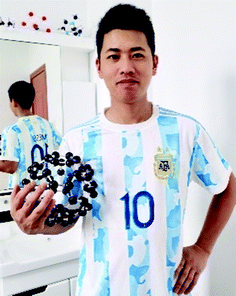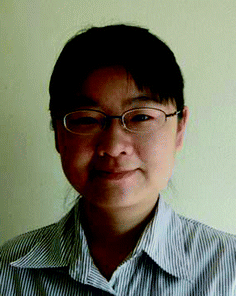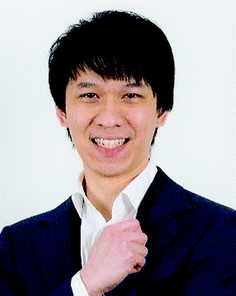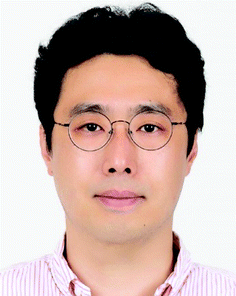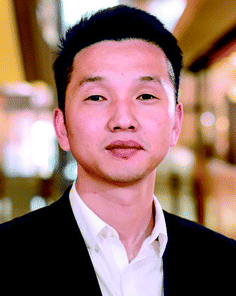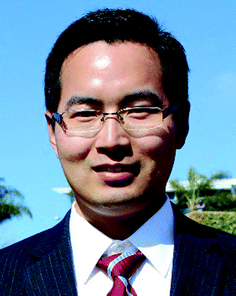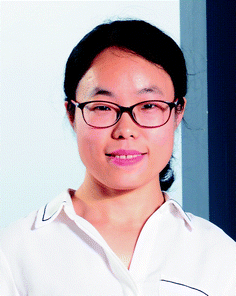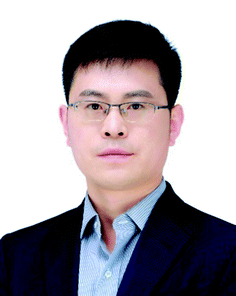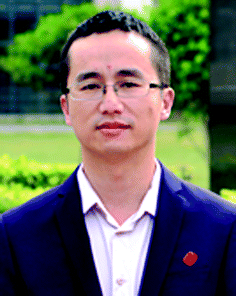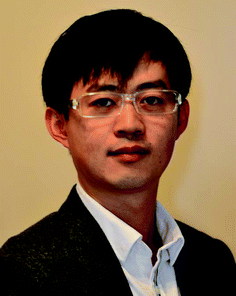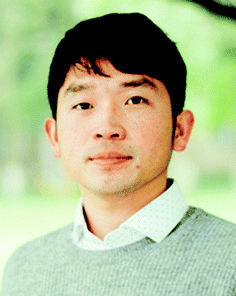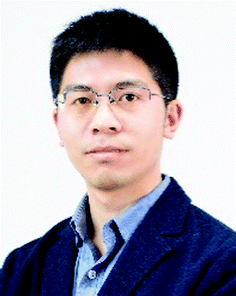Contributors to the Emerging Investigators Collection 2021
Dr Sarit S. Agasti received his MSc degree in Chemistry from the Indian Institute of Technology, Kanpur in 2005. He then moved to the University of Massachusetts Amherst, US, to pursue his doctoral research under Prof. Vincent M. Rotello. In 2010, he joined Prof. Ralph Weissleder's group at Massachusetts General Hospital/Harvard Medical School as a postdoctoral fellow. Afterward, he worked with Prof. Peng Yin at the Wyss Institute at Harvard University. In 2015, Sarit started his independent career at the Jawaharlal Nehru Centre for Advanced Scientific Research. His research focuses on the interface of chemistry and biology, emphasizing bioimaging, sensing, and delivery.
Tim Allison obtained his PhD in Biochemistry at the University of Canterbury in 2012, before working with Professor Dame Carol Robinson at the University of Oxford as a postdoctoral research assistant. Since 2018, he has been back at the University of Canterbury and is a Senior Lecturer in Chemical Biology, and an Associate Investigator of the Biomolecular Interaction Centre and the Maurice Wilkins Centre for Molecular Biodiscovery. His research combines enzymology, protein crystallography, and native mass spectrometry fundamentals and application to investigate membrane-bound proteins.
Fátima Aparicio obtained her PhD degree in 2014 from Universidad Complutense de Madrid (Spain). She carried out a postdoctoral stay of 2 years in France. In 2016, she joined Prof. D. González-Rodríguez's research group at the Universidad Autónoma de Madrid, funded by two Marie Skłodowska-Curie Fellowships: Cofund and an Individual Fellowship. She has recently been awarded her first project as main researcher, funded from the Spanish MICINN (2021–2024). She is very interested in the formation of chiral supramolecular structures. When not at work, she loves enjoying the mountains with her little family.
Veronica Augustyn is an Associate Professor of Materials Science & Engineering and a University Faculty Scholar at North Carolina State University. She also serves as an Associate Editor for the Journal of Materials Chemistry A. Her research focuses on the relationships between material structure, composition, and morphology, and the resulting electrochemical mechanisms for energy-relevant processes. She leads an award-winning international project at NC State, SciBridge, which develops renewable energy research and education collaborations between universities in Africa and the U.S. Outside of research, she enjoys spending time with her family and the great outdoors.
Debasis Banerjee graduated with a MSc degree in Organic Chemistry from Banaras Hindu University and obtained his PhD in Organic Chemistry from the Indian Institute of Technology Kanpur in 2011. Thereafter, he moved to the Leibniz Institute for Catalysis (LIKAT), Germany, as a Leibniz postdoctoral fellow with Prof. Matthias Beller (2011–14) and subsequently held another postdoctoral position (2014–2015) at Stockholm University, Sweden, with Prof. Jan-Erling Bäckvall. Currently, he is an Associate Professor at the Indian Institute of Technology, Roorkee. His research interests include sustainable catalysis, C–H bond functionalization and enantioselective catalysis. He is a recipient of the DAE-Young Scientist Research Award (2016) and Thieme Chemistry Journals Award (2020).
Jonathan Barnes completed his undergraduate education in Chemistry at the University of Kentucky in 2006 with Bob Grossman, before working for a few years in industry in Los Angeles, CA. Jonathan started his graduate studies in 2010 as a National Defense Science and Engineering Graduate Fellow at Northwestern University in Evanston, IL under the tutelage of Professor Fraser Stoddart. In 2014, Jonathan moved to MIT as an HHMI postdoctoral fellow of the Life Sciences Research Foundation in Professor Jeremiah Johnson's group. He began his independent career at WUSTL in 2016, where his group has focused on synthesizing new functional polymers for use in photodynamic materials, polymeric nanomaterials for drug combination therapies, and developing novel, topologically complex polymers and materials. Jonathan received a Fellowship for Science and Engineering from the David and Lucile Packard Foundation and was named a 2019 Kavli Fellow by the Kavli Foundation and the U.S. National Academy of Sciences, as well as a 2020 Polymeric Materials: Science and Engineering Young Investigator by the American Chemical Society.
Marcus Baumann received his first degree from Philipps-University Marburg (Germany) before studying for a PhD with Prof. Steven V. Ley at the University of Cambridge (UK) in the area of continuous flow chemistry. After postdoctoral stints in California (Prof. Larry E. Overman) and Durham (Prof. Ian R. Baxendale) in 2017 he took up an Assistant Professorship at University College Dublin, where his research group focuses on developing new flow processes in view of industrial applications. He currently targets photochemical and biocatalysed processes, as well as reaction telescoping and scale-up.
Dr Chandan Bera is working as a scientist at the Institute of Nano Science and Technology, Mohali. He received his MSc degree from the Indian Institute of Technology, Bombay in 2007 and his PhD degree from École Centrale Paris in 2010. Currently, he is working on computational nanoscience. His group is interested in clean and renewable energy generation and conversion. He also works on thermal and electron transport mechanisms and developing a simple predictive model for thermal and electron transport in 2D and nanostructure materials.
Katharina Boguslawski is an Associate Professor at the Institute of Physics, NCU in Toruń. She obtained her PhD in Chemistry in 2013 from the ETH, Zurich. After being a postdoctoral fellow at McMaster University (Canada), she joined the Institute of Physics (NCU) in 2016 as an Assistant Professor to establish her own research group. In 2019, she obtained her habilitation in physics. Professor Boguslawski has been awarded various research grants and stipends, such as a MSCA-IF-EF. Her scientific activity covers the development of electronic structure methods for ground and excited states at the interface of physics and chemistry.
Yury Budkov obtained his master’s degree in theoretical physics from Dubna State University, Dubna, Russia in 2010. During his study, he worked as a senior assistant at the N. N. Bogolyubov laboratory of theoretical physics of JINR. During 2010–2013, he was a PhD student at the Institute of Solution Chemistry of the Russian Academy of Sciences (ISC RAS), Ivanovo, Russia. In 2013, he earned his PhD in physical chemistry there. In 2014, he was invited to the Max Planck Institute of Applied Mathematics, Leipzig, Germany as an invited researcher. In 2015, he got the position of Senior Lecturer at the HSE University, Moscow, Russia and, in 2017, Associate Professor at the same University. In 2019, Yury defended his doctoral thesis in condensed matter physics at the HSE University and then got a position of Head of Laboratory at the ISC RAS. In 2020, he got a Professor position there. His basic research focuses on the statistical mechanics of soft matter, molecular fluids, and electrolytes.
Hujun Cao is an Associate Professor at Dalian Institute of Chemical Physics (DICP), CAS, China. He got this position in 2018 after 4 years of postdoctoral research at Helmholtz-Zentrum Geesthacht (HZG), Germany. He obtained his PhD in chemical physics from DICP in 2014, under the supervision of Prof. Ping Chen and Prof. Jieshan Qiu. His research interests cover the synthesis, characterization and utilization of novel hydrogen storage materials and development of new ionic conductors.
Christopher Caputo began his independent career in 2017 as an Assistant Professor and Canada Research Chair at York University. Prior to this, he led the development of semi-permanent tattoo technology as Director of Research and Development at Inkbox, a successful Canadian start-up company. This experience shapes his group’s research interests, exploring both fundamental main-group reactivity and entrepreneurial research towards the sustainable generation of new dyes. He has received several awards, including the 2018 John Charles Polanyi Prize in Chemistry, the highest honour awarded to early-career scientists by the Province of Ontario. In 2020, he co-founded Elect STEM, a not-for-profit organization seeking to engage more scientists in politics.
Brad Carrow obtained his PhD in 2011 from the University of Illinois at Urbana-Champaign in the labs of John F. Hartwig. He was a postdoctoral fellow and then Research Assistant Professor in the labs of Kyoko Nozaki at the University of Tokyo. He was an Assistant Professor at Princeton University and currently is an Associate Professor at the University of Houston. His research group aims to develop transition metal catalysts and mechanistic knowledge targeting long-standing sustainability challenges in chemical synthesis and the discovery of catalytic routes to next-generation polymers that can mitigate the problems of plastics pollution and recycling.
Andrew Cassidy graduated with a BSc in Chemistry from University College Dublin, Ireland, before moving to the University of Cambridge, UK to work towards a PhD with Prof. Bill Jones, at the Department of Chemistry. In 2010, Andrew moved to Aarhus University, Denmark and combined his interest in molecular solids with a desire to understand the chemical diversity of the interstellar medium. Andrew is now the centre manager for the Center for Interstellar Catalysis, at Aarhus University. He enjoys foraging in the forest with his daughter and continuously failing to get better at playing the piano.
Rambabu Chegondi received his MSc degree from the University of Hyderabad and completed his PhD in Organic Chemistry (2009) from the Indian Institute of Chemical Technology (CSIR-IICT), Hyderabad under the supervision of Dr S. Chandrasekhar. After a post-doc stint at The University of Kansas, USA in Prof. Paul R. Hanson's research group, he started his independent research career in 2015 at CSIR-IICT, Hyderabad. He is currently working as a Senior Scientist and his research interests focus on the development of new catalytic enantioselective desymmetrization methods and their application towards the synthesis of biologically important complex molecules. Recently, he received the prestigious AVRA Young Scientist Award-2019.
Dr Jun Chen is an Assistant Professor in the Department of Bioengineering at UCLA. His research focuses on wearable bioelectronics and smart textiles. With a current h-index of 75, he has recently been recognized by the IAAM Scientist Medal, 30 Rising Leaders in Life Science by Informa, ACS Nano Rising Stars Lectureship Award, 2020 Altmetric Top 100, Okawa Foundation Research Award, Journal of Materials Chemistry A Emerging Investigator Award, Nanoscale Emerging Investigator Award, Frontiers in Chemistry Rising Stars, Top 10 Science Stories of 2020 by Ontario Science Centre and the Highly Cited Researchers 2020/2019 in Web of Science. He is an associate editor of Biosensors and Bioelectronics.
Ming Chen completed his PhD studies at Scripps Research, Florida under the supervision of Professor William R. Roush. Then, he moved to the University of California, Berkeley and conducted his postdoctoral studies in the laboratory of Professor John F. Hartwig. While playing guitar is certainly his great passion, creating molecules and exploring the world of chemistry are more exciting to him. He started his independent career in 2016 at Auburn University. His research interests mainly focus on asymmetric catalysis and complex molecule synthesis.
Weiqiang Chen is an Associate Professor of Biomedical and Mechanical Engineering and leads the Applied Micro-Bioengineering group at New York University. He received his PhD degree in mechanical engineering from the University of Michigan in 2014. His research has been focused on micro-engineering cell behaviors and environments with lab-on-a-chip, organ-on-a-chip, and micromechanical systems to address emerging biomedical problems in cancer biology, immune engineering, cell mechanobiology, and regenerative medicine. He has received numerous awards, including the Biomedical Engineering Society Cellular and Molecular Bioengineering Rising Star Award (2021) and the Young Innovator Award (2019).
Lingling Chu was born in Anhui Province (China). She obtained her BSc in Engineering from Hefei University of Technology in 2007 and her PhD from the Shanghai Institute of Organic Chemistry (SIOC) in 2012, working with Professor Feng-Ling Qing on organofluorine chemistry. She then spent three years as a postdoctoral research associate with Professor David MacMillan at Princeton University, working on photoredox catalysis. In 2016, she started her research group as a Professor at Donghua University. Her research interests focus on the field of transition metal catalysis and radical chemistry.
Eduardo Coutino-Gonzalez is fascinated by the intricate host–guest relationships of luminescent species confined in micro(meso)porous materials. This fascination began during his doctoral studies at the KU Leuven (Belgium), where he obtained his PhD in 2015 under the supervision of Prof. Johan Hofkens and Prof. Bert Sels. After spending one year as postdoctoral fellow in Prof. Hofken's group, he moved to Mexico to pursuit an independent career, being appointed as head of the Nanophotonics and Functional Materials laboratory in 2019 at CIO (Optics Research Centre), combining the role of researcher and mentor for the younger generations.
Dr Matthew Cowan has jumped from inorganic chemistry to chemical engineering and picked up a business degree along the way while working in New Zealand, Australia, France, and the United States. His research group identifies commercial opportunities for separation technologies, designs process operations to meet those needs, and develops the materials required to transform those process designs from fantasy to reality. Outside the University of Canterbury, he has been seen performing standup comedy, swimming in the ocean, and at markets selling his children's book “Because I Cleaned My Room.”
Alejandro Criado received his BSc degree in Chemistry, followed by his PhD in Organic Chemistry at the University of Santiago de Compostela. In 2013, he was a postdoctoral fellow at the University of Trieste, working on new chemical modification approaches of carbon-based nanomaterials. In 2015, he moved to the CIC biomaGUNE research center, where he developed modified nanomaterials for bioapplications, with different research grants, including a Juan de la Cierva – Incorporacion. Currently, he is a “Xunta de Galicia” – Distinguished Researcher at Centro de Investigacións Avanzadas (CICA) – Universidade da Coruña, where he leads his own group. His research interests focus on new preparation and modification methods of carbon nanostructures and other 2D materials to tailor their properties, along with the development of new sensors. In summary, he is a science lover “trapped” in the world of carbon-based materials.
Dr Chaohua Cui is currently an Associate Professor at Soochow University. He received his BS degree in July 2009 from the Beijing Institute of Technology, a MS degree in July 2011 from the Beijing University of Chemical Technology (co-supervised by Prof. Yongfang Li in ICCAS), and his PhD degree in Chemistry in 2014 from Hong Kong Baptist University under the supervision of Prof. Wai-Yeung Wong. His research focus is on developing novel conjugated polymer and small-molecule donor materials for organic solar cells.
Yunlu Dai is an Assistant Professor in the Faculty of Health Sciences, University of Macau. He received his PhD in 2014 from the Changchun Institute of Applied Chemistry (CIAC), Chinese Academy of Sciences under the supervision of Prof. Jun Lin. Then, he moved to the University of Melbourne as a research fellow with Prof. Frank Caruso. In 2016, he joined Dr Xiaoyuan (Shawn) Chen's Laboratory at the National Institutes of Health (NIH) as a postdoctoral student. He initiated his independent research program in 2018 at the University of Macau. His research focuses on multifunctional hybrid nanomaterials for biomedical applications.
Prof. Christopher Dares completed his PhD in 2012 under the supervision of Prof. A. B. P. (Barry) Lever at York University, Toronto, Canada, and worked on photocatalytic hydrogen production. He went on to work with Prof. Thomas J. Meyer at The University of North Carolina at Chapel Hill, where he studied electrochemical and photoelectrochemical oxidation reactions. He joined the chemistry faculty at Florida International University as an assistant professor in 2016, where his research focuses on the development of electrode materials to facilitate f-element redox transformations, with a special interest in transuranic elements.
Dr Davies’ lab explores the chemical and physical properties of aerosol particles to better understand their role in the atmosphere, engineering applications, and health. Dr Davies develops methods to levitate single aerosol particles and probe their size and composition using light scattering techniques and mass spectrometry. Through single particle analysis, his lab reveals the hygroscopicity, optical properties, particle-phase diffusivity, and chemical evolution of aerosols under ambient environmental conditions.
Prof. Letian Dou is currently the Charles Davidson Assistant Professor of Chemical Engineering at Purdue University. He obtained his BS in Chemistry from Peking University in 2009 and his PhD in Materials Science and Engineering from UCLA in 2014. From 2014 to 2017, he was a postdoctoral fellow at the Department of Chemistry, UC Berkeley. His research interests include the synthesis of organic–inorganic hybrid nanomaterials and the fundamental understanding of their structure–property relationships, as well as their applications in high performance optoelectronic devices. He is a recipient of the Office of Naval Research Young Investigator Award, Highly Cited Researcher in Cross-Fields, the MIT Technology Review Innovators Under 35-China Award, and the Materials Research Society Graduate Student Award.
Yuval Elani is a UKRI Future Leaders Fellow and Lecturer at the Chemical Engineering department at Imperial College London. His group works on biomimetic technologies, microfluidics, and synthetic biology. Yuval has been awarded several prizes for academic excellence, including the Royal Society of Chemistry Felix Franks Medal for Biotechnology and the Imperial President's Medal. He is co-founder of the fabriCELL centre for artificial cell research and is co-director of the Membrane Biophysics Platform at Imperial. Yuval grew up in South Africa, Israel and the UK. He is an avid Gooner, enjoys playing tennis, and loves spending time with his kids.
Katherine Elvira is an Assistant Professor, Canada Research Chair and Michael Smith Foundation for Health Research Scholar at the University of Victoria. While enjoying beautiful British Columbia (whales, snowboarding, beaches, we could go on), her interdisciplinary research group builds artificial cells and tissues for drug discovery. Katherine is interested in how microfluidic devices have impact outside the field, and is a Scientific Mentor for exciting start-ups with the Creative Destruction Lab. Having studied at Imperial College London, and been a postdoc at ETH Zurich, she has continued travelling the world to give over 35 invited seminars in the last four years. Photo credit to UVic Photo Services.
Wei-Hui Fang graduated from HuaQiao University in 2009 with a BS in Chemical Engineering. Then, she worked as a research assistant at the Fujian Institute of Research on the Structure of Matter, Chinese Academy of Sciences (hereinafter FJIRSM-CAS), where she got her start in inorganic chemistry research with Professor Guo-Yu Yang. In 2013, she received her PhD degree in physical chemistry. From October 2016 to October 2017, she studied with Professor Dominic Wright in University of Cambridge as a visiting scholar under the sponsorship of the China scholarship council. Since January 2019, she has been working as a Full Research Professor at FJIRSM-CAS. Her current research interests are the synthesis and application of aluminum oxo clusters and aluminum molecular rings.
Jeremy Feldblyum's love of science was inspired by enthusiastic teachers and a supportive family of scientists and musicians. After a brief foray into classical piano performance, Feldblyum dedicated his studies to chemistry, earning BS and BMus degrees from the University of Maryland. Pursuing a PhD with Adam Matzger and David Gidley at the University of Michigan introduced Feldblyum to the world of porous materials; postdoctoral work in Zhenan Bao's group at Stanford University sparked a passion for electronic materials. An Assistant Professor at SUNY Albany, Feldblyum is developing new functional coordination materials for electronics, separations, and catalysis.
Dr Huile Gao received his PhD in Pharmaceutics from School of the Pharmacy, Fudan University in 2013. Then, he joined the West China School of Pharmacy, Sichuan University. Dr Gao's research interests focus on the design, synthesis, characterization and evaluation of stimuli responsive nanomaterials for drug delivery to improve tumor and brain disease treatment. He is a 2020 highly cited Chinese researcher (Scopus), and has published over 150 peer-reviewed articles, with an H-index of 53. He served as editor of the books Neurotoxicity of Nanomaterials and Nanomedicines and Brain Targeted Drug Delivery Systems. He is now serving as an Editorial Board Member of IJP, Pharmaceutics, etc.
Peng Gao received his PhD in Chemical Engineering and Technology in 2014 from the University of the Chinese Academy of Sciences (UCAS). He became a Research Group Leader at the Shanghai Advanced Research Institute (SARI), Chinese Academy of Sciences (CAS) in 2017. Currently, he works as a full Professor at SARI and UCAS and focuses on the conversion of C1 molecules (CO, CO2, CH4, CH3OH, etc.) into chemicals and fuels via heterogeneous catalysis. He was recognised by the Youth Innovation Promotion Association, CAS in 2018, as well as the Top Young Talents in Shanghai, and was granted the Shanghai Rising-Star Award in 2019.
K. Geetharani obtained her PhD from the Indian Institute of Technology, Madras in 2012. Soon after, she moved to the University of Wurzburg, Germany for her postdoctoral studies with Prof. Holger Braunschweig as an Alexander von Humboldt fellow and began her independent research career as an Assistant Professor in the Department of Inorganic and Physical Chemistry, Indian Institute of Science, Bangalore, India, in 2016. She is a recipient of a DST Inspire Faculty Award. She is a Young Associate of the Indian Academy of Sciences and has also been awarded the INSA Young Scientist medal, NASI Young Scientist Platinum Jubilee Award and SERB Women Excellence Award. Her research interests are in the areas of catalysis, main group and organometallic chemistry.
Born in Bathurst, New Brunswick, Canada, Robert Godin has been interested in photochemistry since the start of his higher education. After learning a breath of photochemistry and spectroscopy techniques working with Prof. Tito Scaiano (BSc, University of Ottawa) and Prof. Gonzalo Cosa (PhD, McGill University), Robert completed a postdoctoral stint with Prof. James Durrant at Imperial College London and entered the field of solar energy conversion. In 2018, he established his independent group at UBC in Kelowna. The group develops time-resolved spectroscopic tools to better understand carbon-based semiconductors for sustainable energy production, with a healthy dose of physical organic chemistry concepts.
Lutz Greb grew up in the wine regions Mosel and Pfalz, went to study Chemistry in Freiburg (Baden, another wine region), and finished his PhD in Karlsruhe (with Jan Paradies) on frustrated Lewis pairs (with a research stay in Toronto with Doug Stephan). In Strasbourg, Lutz switched imine molecular motors with Jean-Marie Lehn and pursued independent research in Inorganic Chemistry at Heidelberg University. Currently, his group aims to push p-block elements in their normal oxidation states out of their comfort zone by strong ligand effects.
Zhi-Gang Gu obtained his PhD degree from the Karlsruhe Institute of Technology (KIT) in 2014, then he worked as a postdoctoral fellow in KIT. In 2015, he was made an Associate Professor and in 2018, he was promoted to a Professor at the Fujian Institute of Research on the Structure of Matter (FJIRSM), Chinese Academy of Sciences (CAS). His recent research has focused on the controllable assembly and functionalities of surface-coordinated metal–organic framework thin films (SURMOFs).
Dr Jianping Guo is Professor at the Dalian Institute of Chemical Physics (DICP), Chinese Academy of Sciences (CAS). His main scientific interests are the preparation of inorganic hydride (H−)-containing materials, characterization of their physico-chemical properties and their applications in the activation and transformation of important small molecules, including N2, H2 and NH3. He and his colleagues have been dedicated to the development of advanced materials and novel approaches for sustainable ammonia production, efficient ammonia separation, and versatile ammonia utilization in recent years.
Professor Jeffrey Gustafson received his BS in Chemistry from SDSU in 2005, and earned his PhD with an emphasis in organic chemistry at Yale under the supervision of Scott Miller, working on the development of peptide catalyzed halogenations. In 2011, he began post-doctoral studies in the Yale Department of Molecular, Cellular and Developmental Biology with Craig Crews, where he worked on targeted protein degradation. In 2013, Professor Gustafson started his independent career back at SDSU, where his lab focuses on studying all aspects of atropisomerism. At SDSU, he mentors young scientists at all levels, including undergraduates, graduate students and post-doctoral researchers.
Osvaldo Gutierrez was born in Mexico and raised in Sacramento, California. He attended Sacramento City College and obtained his BS/MS in 2009 working with Prof. Houk. In 2012, he obtained his PhD (UC Davis) under the guidance of Prof. Tantillo. As a postdoc with Prof. Kozlowski (UPenn), he used computational and experimental tools to study transition metal-catalyzed processes. He started his independent career at University of Maryland and, in 2021, moved to Texas A&M University as an Associate Professor, where his research combines computational and experimental approaches to advance our understanding of iron- and photo-catalyzed reaction mechanisms. He loves 90s rap.
Dr Eva Hemmer is an Associate Professor of Materials Chemistry at the University of Ottawa, Canada. She received her PhD in materials science from Saarland University, focusing on the bottom-up synthesis of inorganic nanomaterials. This experience was further deepened during her postdoctoral studies at the Tokyo University of Science (2009–2012). She then joined the Institut National de la Recherche Scientifique (Montreal, Canada) as an Alexander-von-Humboldt postdoctoral fellow to develop lanthanide-based optical nanothermometers. In the winter 2016, Eva came to Ottawa; since then, her research has focused on new designs of nanoparticles for bioimaging and optomagnetic applications, and the understanding of structure–property relationships.
Zeinab Hosseinidoust is an Assistant Professor (tenure track) in the Department of Chemical Engineering at McMaster University and holds a Canada Research Chair (Tier 2) position in Bacteriophage Bioengineering. She obtained her PhD degree from McGill University (Montreal) and completed her postdoctoral training at the Max Planck Institute for Intelligent Systems (Germany). She has received over 10 scholarships and awards, and currently leads a team of 10 graduate students and research associates.
Her research program is focused on bridging the gap between microbiology and engineering design. Her research specifically focuses on responding to two global biological threats, namely antibiotic resistance and viral infections, by employing bacteriophages (bacterial viruses). Patented technologies developed in her lab have gained recognition from academics, industry, and Health Canada, and self-healing phage hydrogels developed in her lab have been widely covered in public media.
Yongjie Hu is an Associate Professor in the School of Engineering and Applied Science at the University of California, Los Angeles (UCLA). His group exploits interdisciplinary experimental and theoretical approaches to investigate energy transport mechanisms and device applications, with a current emphasis on developing advanced materials and experimental metrologies to characterize nanoscale energy processes. Before joining the faculty of UCLA, he received his PhD degree from Harvard University and a postdoctoral fellowship from the Massachusetts Institute of Technology. His research has been recognized by diverse research societies, including an Alfred P. Sloan Research Fellowship, ASME Bergles-Rohsenow Young Investigator Award, National Science Foundation's CAREER Award, and U.S. Air Force Young Investigator Award.
Lizhen Huang obtained her Bachelor’s degree from Huazhong University of Science and Technology in 2006. Then, she went to the Changchun Institute of Applied Chemistry and received her PhD degree in 2011. After that, she joined Prof. Frank Würthner's group as a postdoc at the Universität of Würzburg. Currently, she is a Professor in the Institute of Functional Nano & Soft Materials (FUNSOM) at Soochow University. Her research interests are in controlling the growth of structured organic semiconductor thin films and developing their applications in various sensors.
Mine Ince is a Full Professor working at Tarsus University, Turkey, developing independent research with her small research team working mainly in the field of molecular photovoltaics. Her research focuses on the development of molecular materials based on phthalocyanines and structural analogues for applications in organic solar cells, perovskite solar cells, CO2 reduction and hydrogen production. Her PhD thesis was awarded the NanoMatMol 2012 prize of the Spanish Royal Society of Chemistry. She also received the National UNESCO–L’Oréal “For Women in Science” award in 2016, the prestigious Distinguished Young Scientist Award (GEBIP) of the Turkish Academy of Sciences in 2018, and in 2019 the Prof. Dr Mustafa Parlar Foundation Research Incentive Award.
Biman Jana received his PhD from the Indian Institute of Science, Bangalore, India (2010) in the group of Prof. Biman Bagchi. After a postdoctoral stay with Prof. Jose Onuchic at UCSD and Rice University (2011–2013), he started his independent career at the Indian Association for the Cultivation of Science, Kolkata, India as an Assistant Professor. Since 2017, he has been an Associate Professor in the School of Chemical Sciences. His group is interested in theoretical and computational biophysical chemistry with a special emphasis on exploring the mechanochemical cycle of molecular motor proteins and ice growth modulation by ice binding proteins.
Arturo Jiménez-Sánchez is an Assistant Professor at the Institute of Chemistry at UNAM in Mexico City. He graduated in Chemical Engineering and earned his PhD in Chemistry at the Center for Research and Advanced Studies (Cinvestav) in Mexico City, followed by two postdoctoral fellowships at the University of Toronto with Prof. Shana Kelley and at the Faculty of Chemistry of UNAM with Prof. Anatoly Yatsimirsky. He has carried out two research stays at ENS Cachan in Paris and at the LCC in Toulouse, France. His research interests focus on the development of new bioanalytical protocols to measure subcellular chemical and physical processes.
Garima Jindal is originally from Delhi and completed her undergraduate and postgraduate studies in Chemistry at the University of Delhi. She then moved to another metropolitan city, Mumbai, to pursue her graduate studies in the group of Prof. Sunoj at IIT, Bombay. To explore the world of enzymes, she started working as a postdoctoral fellow with Prof. Warshel at the University of Southern California. In 2019, she joined the Indian Institute of Science (IISc), Bangalore as an Assistant Professor, where her group uses a combination of computational methods (QM, QM/MM, MD) to understand the intricacies of carbene transfer reactions catalyzed by enzymes and transition metals. She enjoys drawing and reading fiction.
Sam Jones completed his PhD at the University of Cambridge, working with Prof. Oren A. Scherman, where he explored the supramolecular assembly of nanomaterials using cucurbit[n]uril. He then moved to the EPFL, Switzerland to the group of Prof. Francesco Stellacci, where his research focused on chemotactic nanomaterials and broad-spectrum virucidal materials. In 2017, he was awarded a Dame Kathleen Ollerenshaw Fellowship at the University of Manchester, which allowed him to establish his independent research programme focusing on virus/material interactions, with a specific focus on the development of novel virucidal materials and viral detection systems.
Christoph Kerzig studied chemistry at the MLU Halle (Germany), where he obtained his PhD under the supervision of Martin Goez in 2017. He then joined the group of Oliver Wenger at the University of Basel with a Leopoldina postdoc fellowship. During his research stay in Basel, he was also a visiting scientist in Gothenburg, working on upconversion with Karl Börjesson. In 2020, Christoph joined the JGU Mainz as an Assistant Professor. His research focuses on mechanistic photochemistry, spectroscopy and photocatalysis. Outside the lab, he enjoys cycling (to get new scientific ideas, of course) or spending time with his family.
Hyung Ju Kim is currently a senior research scientist at the Korea Research Institute of Chemical Technology (KRICT) and an Associate Professor at the University of Science and Technology (UST). His research group is searching for the answer to the fundamental question of how we can design and develop efficient catalyst and reactor systems that form a bridge between electrocatalysis and sustainable chemical reactions (i.e. biomass conversion, water splitting, etc.). He obtained his BSc from Sungkyunkwan University (South Korea) in 2006, and his PhD from the Gwangju Institute of Science and Technology in 2012 with Prof. Won Bae Kim. From 2012 to 2014, he did postdoctoral research in the laboratory of Prof. George W. Huber (University of Wisconsin-Madison, USA).
Vera Krewald received her PhD in 2014 in the group of Frank Neese at the MPI for Chemical Energy Conversion in Mülheim/Ruhr. Following postdoctoral research in the same group, she obtained a Marie-S.-Curie scholarship for a research project with Leticia González at the University of Vienna. Vera Krewald started her own research group in 2017 at the University of Bath and took up a tenure track professorship at the Technical University Darmstadt in 2018. She is interested in the prediction and analysis of spectroscopic, magnetic and catalytic properties of open-shell transition metal complexes, in particular those that are relevant for light-driven nitrogen activation and electrocatalytic oxygen reduction. Picture credit: Katrin Binner.
Sarah Yunmi Lee received her BS from KAIST and her PhD from MIT in Organic Chemistry under the supervision of Professor Gregory C. Fu in 2014. She then did postdoctoral research at UC Berkeley as an NIH postdoctoral fellow with Professor John F. Hartwig. In March of 2018, Sarah began her independent career in the Department of Chemistry at Yonsei University as an Assistant Professor. Her research group is interested in the design, development, and mechanistic investigations of new catalytic, stereoselective organic transformations.
Prof. Semin Lee was born and raised in South Korea. After receiving his BS and MS from Sogang University (advisor: Prof. Bongjin Moon), he joined the PhD program at Indiana University. He designed various anion receptors under the guidance of Prof. Amar Flood. Semin then worked with Prof. Jeffrey Moore as a Beckman Postdoctoral Fellow at University of Illinois. He focused on synthesizing carbon-rich cages and macrocyclic compounds using alkyne metathesis. Semin started his independent career as an Assistant Professor at Louisiana State University in 2017. His research focuses on developing new alkyne metathesis catalysts and carbon nanohoops.
Dr Juan Li is a Professor at the Ningbo Institute of Materials Technology and Engineering of the Chinese Academy of Sciences. She graduated from the Max Planck Institute of Biological Cybernetics (Germany) in 2008 and obtained her PhD from the University of Tuebingen (Germany) in 2012. Since then, she has worked at the Ningbo Institute of Materials Technology & Engineering of the Chinese Academy of Sciences and was appointed as a Professor in 2020. Her research interests mainly focus on the development of targeted nanosystems for cancer imaging and therapy. She has published more than 30 papers in Nano Today, Biomaterials, Nano Letters, etc., and she has published more than 30 patents. She is a member of the Society for Neuroscience and the Youth Innovation Promotion Association Foundation of CAS, and committee member of China Anti-Cancer Association.
Ting-Ting Li received his PhD from the Technical Institute of Physics and Chemistry, Chinese Academy of Sciences in 2015. He is now an Associate Professor at Ningbo University. His research interests are in understanding material structures and properties, and to establish design principles for transition-metal-based catalysts for photo-/electrochemical reactions, including water splitting and CO2 reduction.
Dr Rengui Li received his PhD degree from the Dalian Institute of Chemical Physics (DICP), Chinese Academy of Sciences in 2014. He worked as a visiting research associate in Prof. K. Domen's group at the University of Tokyo and Prof. Harry Atwater's group at the California Institute of Technology. He was promoted to full Professor at DICP at 2018. His research interests are mainly focused on photocatalytic solar energy conversion. He has published more than 60 papers in Joule, Nature Commun., Angew. Chem. Int. Ed., Adv. Mater. etc., with more than 5000 citations. Dr Rengui Li has won various awards, including the Young Scientist Prize at the International Congress on Catalysis, and is a Rising Star in Catalysis of China. At present, he serves as an editorial board member for Chinese Journal of Catalysis, Chinese Chemical Letters and Journal of Applied Chemistry.
Wei Li completed his BSc degree at UNC-Chapel Hill in 2006 and conducted undergraduate research with Professor Jeffrey Johnson. His PhD research work focusing on nickel catalysis was carried out at the University of Michigan with Professor John Montgomery. He then followed his passion for organocatalysis and photoredox catalysis as a postdoctoral researcher at Princeton with Professor David MacMillan. His independent career began as an Assistant Professor at the University of Toledo in 2015 and he was promoted to Associate Professor in 2021. His research group focuses on the invention of new catalytic avenues to facilitate the divergent syntheses of N-heterocycles.
Hongyang Liu is a full Professor at the Shenyang National Laboratory for Materials Science at the Institute of Metal Research (IMR), Chinese Academy of Sciences (CAS). He received his PhD degree from the Dalian Institute of Chemical Physics (DICP), CAS and received postdoc training at the University of Missouri and Oak Ridge National Laboratory in the United States. His research interests are focused on the synthesis and exploration of applications of atomically dispersed metal catalysts for light alkane activation.
Mark Lipke grew up near Buffalo, NY, where he spent his free time skateboarding and making fireworks. Naturally, he went on to study chemistry, first at Case Western Reserve University (BS, 2008) and then UC Berkeley (PhD, 2013, advisor: Don Tilley), in both cases researching the catalytic properties of transition metal complexes. Mark completed a postdoc in molecular nanoscience with Fraser Stoddart at Northwestern University before starting his independent career at Rutgers in 2017. Research in his group focuses on tuning nanoporous structures to improve the catalytic properties of transition metal complexes, with an emphasis on electrochemical transformations for producing and using fuels.
Dr Jian Liu is an Assistant Professor and Principal's Research Chair in Energy Storage Technologies in the School of Engineering at the University of British Columbia (UBC) Okanagan campus, Canada. Dr Liu received his PhD in materials science (2013) from the University of Western Ontario (Canada) and worked as an NSERC Postdoctoral Fellow at the Lawrence Berkeley National Laboratory and Pacific Northwest National Laboratory, before joining UBC in January 2017. His current research interests focus on advanced nanofabrication techniques, materials design for Li-ion batteries and beyond, and interfacial control and understanding in energy storage systems.
Jinyao Liu is a full Professor at the Institute of Molecular Medicine, School of Medicine, Shanghai Jiao Tong University (SJTU), China. After he received his PhD at SJTU in Materials Science and Engineering under the supervision of Prof. Deyue Yan, Jinyao joined Prof. Ashutosh Chilkoti’s group in the Department of Biomedical Engineering at Duke University (2013–2015) and Prof. Robert Langer's laboratory in the Koch Institute for Integrative Cancer Research at MIT (2015–2018) as a postdoc associate. His current research interests include oral delivery, bacterial-based bioagents, and nanomedicines. Jinyao's publications have been featured by MIT News, Nature Communications Editors’ Highlights, Hunan TV, etc.
Meng Liu obtained a PhD in Environmental Engineering from Dalian University of Technology in 2012. He was a postdoctoral fellow at McMaster University between 2013 and 2017. He is now a Professor in the School of Environmental Science and Technology at Dalian University of Technology. His research interests include functional DNAs and paper-based microfluidics.
Xingchen Liu is currently an Associate Professor at the Institute of Coal Chemistry, Chinese Academy of Sciences. He obtained his BSc degree and MSc degree in Physical Chemistry from Jilin University (China). He earned his PhD in Computational Chemistry at the University of Calgary (Canada). From 2017–2018, he worked as a visiting scientist at Cornell University (US). His research interests focus on understanding the fundamental principles of the conversion of carbon-based resources and using this knowledge to design new chemical processes for energy and environmental applications.
Stacey Louie is an Assistant Professor in the Department of Civil and Environmental Engineering at the University of Houston. She received her PhD from Carnegie Mellon University in 2014 and conducted a U.S. National Research Council (NRC) postdoctoral fellowship at the National Institute of Standards and Technology (NIST) – Gaithersburg from 2014 to 2016. Her research contributes to the field of environmental nanotechnology, including sustainable applications of nanotechnology, as well as environmental implications, with a special focus on analytical method development to characterize nanomaterials and their transformations in complex matrices.
Dr Louis Morrill received his PhD from the University of St Andrews in 2014 under the direction of Prof. Andrew Smith and undertook postdoctoral research at UC Berkeley with Prof. Richmond Sarpong. In June 2015, he initiated his independent research career at Cardiff University. Research in the group is focused on inventing new reactions in organic chemistry and developing sustainable catalytic methodologies for synthesis.
Dawen Niu is a professor of the State Key Laboratory of Biotherapy and the department of Chemical Engineering at Sichuan University. He obtained his PhD degree in 2013 under the tutelage of Professor Thomas R. Hoye from University of Minnesota, Twin Cities, and then worked as a postdoctoral associate in the group of Stephen L. Buchwald at MIT till 2015. His research interest focuses on the development of new methodologies for more efficient synthesis of carbohydrate derivatives, in order to facilitate the exploration of these compounds in fields including medicinal chemistry, biochemistry and material sciences.
Rodrigo Noriega is an Assistant Professor of Chemistry at the University of Utah, where he splits his time between the laser lab, the red rock desert, the high altitude forest, and the snow-covered slopes. His research studies how heterogeneous and dynamic environments affect charge/energy transfer and molecular recognition in soft matter systems. Originally from Mexico, his training includes a Bachelor's degree in Engineering Physics from Tecnologico de Monterrey, a PhD in Applied Physics from Stanford University, advised by Professor Alberto Salleo, and postdoctoral work at the University of California Berkeley, advised by Professor Naomi S. Ginsberg.
Guanghui Ouyang received his BSc from the University of Science and Technology of China in 2010 and obtained his PhD degree from the Institute of Chemistry, Chinese Academy of Sciences (ICCAS) in 2015, with a thesis on chiral supramolecular catalysis. He spent one year (2019–2020) at the University of Würzburg, Germany as a visiting scholar, working on luminescent supramolecular macrocycles. He has been an Associate Professor at ICCAS since 2018. His research interests are in the rational synthesis, switchable supramolecular self-assembly, and circularly polarized luminescence of chiral π-amphiphiles.
Min Hyuk Park has been an Assistant Professor at the Department of Materials Science and Engineering in Seoul National University since 2021. He received his BS and PhD degrees in Materials Science and Engineering from Seoul National University, Seoul, Korea, in 2008 and 2014, respectively. He worked as a postdoc at Seoul National University (2014–2015) and NaMLab gGmbH, Germany (2015–2018), and worked as an Assistant Professor at Pusan National University (2018–2021). His research interests include (anti)ferroelectrics for modern and future semiconductors, energy storage/harvesting, and sensors. He has (co)authored more than 90 publications (cited > 5000 times) in peer-reviewed journals.
Young Park received his PhD from Columbia University in 2010 under the supervision of Professor Colin Nuckolls. While in New York, Young met his adorable dog JK. After his postdoctoral studies with Professor Barney Grubbs at Brookhaven National Lab and Professor Alon Gorodetsky at UC Irvine, Young returned to South Korea in 2016. Since 2016, he has led an independent research group at UNIST in the field of conjugated organic materials. Outside of the lab, Young enjoys hiking around the Yeongnam Alps, which comprises a group of relatively tall mountains located in Ulsan, with his wife and JK.
Ionnis Pavlidis joined the University of Crete (GR) in 2018, as an Assistant Professor of the Department of Chemistry, focusing his research on biocatalysis. Prior to joining the University of Crete, he was a group leader at the University of Kassel (DE) and Research Associate at the University of Greifswald (DE). He is a graduate of the University of Ioannina, where he majored in Biological Applications and Technologies and in Pedagogy. He currently lives in Heraklion, with his lovely family, hosted by his cat. When he is not tackling biocatalytic challenges, he loves to play music and football.
Maxwell Robb obtained his BS in Chemistry from the Colorado School of Mines in 2009, and his PhD in Chemistry from the University of California, Santa Barbara in 2014 with Prof. Craig J. Hawker. His doctoral research focused broadly on the synthesis of functional organic materials and was recognized by the American Chemical Society with the 2016 Henkel Award for Outstanding Graduate Research in Polymer Chemistry. From 2014–2017, Max conducted postdoctoral research with Prof. Jeffrey S. Moore at the University of Illinois, Urbana-Champaign as a Beckman Institute Postdoctoral Fellow. He joined Caltech as an Assistant Professor of Chemistry in September 2017.
Benjamin Rotstein received his PhD from the University of Toronto under the supervision of Prof. Andrei Yudin in 2012, followed by a postdoctoral fellowship at Harvard Medical School and Massachusetts General Hospital with Dr Neil Vasdev. Returning to Canada in 2016, he joined the University of Ottawa to begin his independent research group to develop isotopic labeling strategies and radiotracers for cardiovascular molecular imaging. Ben is excited by learning new things in the lab and beyond; chemical reactivity, the heart, languages, the Ottawa Graben, and the minds of toddlers are some of his current interests.
Tsuneaki Sakurai received his PhD in 2012 from the University of Tokyo, Japan, under the supervision of Professor Takuzo Aida. In 2012, he joined the group of Professor Shu Seki as a postdoctoral fellow at Osaka University (JSPS PD in 2013–2014). In 2014, he started to work as an Assistant Professor in the same group. The group was moved to Kyoto University in 2015, and he was an Assistant Professor there from 2015–2019, and was then promoted to Junior Associate Professor in 2019. Since 2020, he has been working in the current position of Junior Associate Professor at the Kyoto Institute of Technology, Japan. His research group focuses on the design, synthesis, and evaluation of the physical properties of novel luminescent organic materials, organic semiconductors, liquid crystals, and various supramolecular systems.
Dr Haritz Sardon has been an Assistant Professor at the UPV/EHU since 2018. He graduated from the UPV/EHU in 2011, before joining the group of Dr Hedrick at the IBM Almaden Research Center as a postdoc in 2012. In 2014, he returned to POLYMAT as group leader. He has participated in 105 peer-reviewed publications (more than 50 as corresponding author). He has received several awards, including the Excellence of Young Researcher in Chemistry Award by the Spanish Royal Society (2021).
His overall research aims to prepare new functional polymeric materials employing greener polymerization processes, such as monomers from plastic recycling, reagents from renewable sources or the use of less hazardous organocatalysts.
Nathan D. Schley is an Assistant Professor at Vanderbilt University. His academic trajectory began at Sacramento Community College, which led into his BS degree at the University of California, Davis. It was while working with Prof. Philip Power at Davis that he developed a passion for organometallic chemistry. His PhD studies were conducted at Yale University with Prof. Robert H. Crabtree. In 2012, Nathan joined the laboratory of Prof. Gregory C. Fu at the California Institute of Technology as an NIH-NRSA Fellow. His group at Vanderbilt University focuses on developing catalysts for alkane borylation and the cleavage of carbon–oxygen bonds.
Kyoseung Sim is currently an Assistant Professor in the Department of Chemistry at the Ulsan National Institute of Science and Technology (UNIST), where he has been since Spring 2020. He received his PhD from the University of Houston in Materials Science and Engineering under the supervision of Cunjiang Yu in 2018. His current research focuses on soft electronics with organic semiconductors and their system-level applications. In addition, he loves building LEGO® and plastic model kits and enjoys watching a movie, listening to music, and chatting with his lovely wife.
Pratibha Sharma is a Professor in the Department of Energy Science and Engineering at the Indian Institute of Technology, Bombay. She was the recipient of a Gold medal at master's level and received the “Best thesis award” for her PhD work. Her research interests include hydrogen storage materials and systems, hydrogen utilization, low cost earth abundant materials for photovoltaic applications and materials for biomedical applications. She has more than 70 international journal publications and four patents to her name. Prof. Sharma is leading several multi-institutional R&D projects on hydrogen systems development and integration for different applications, with several institutions and industries as partners.
Lei Shi achieved his PhD degree at DLUT in 2007 under the supervision of Prof. Xiao-Bing Lu. After one year working in Prof. Wei-Min Dai's group at the Hong Kong University of Science and Technology, he worked with Prof. Andreas Gansäuer at Bonn University as a postdoc, supported by the Alexander von Humboldt Foundation. In 2010, he joined Prof. Yong-Gui Zhou's group at the Dalian Institute of Chemical Physics (DICP), Chinese Academy of Sciences (CAS). Since 2018, he has been a full Professor of Organic Chemistry at DLUT. His research interests are in developing new catalytic methodologies for asymmetric chemical transformations.
Jun Shimokawa is an Associate Professor in the Department of Chemistry, Graduate School of Science, Kyoto University. He earned his PhD (2011) from the University of Tokyo under the guidance of Prof. Tohru Fukuyama. After experience as an Assistant Professor in the University of Tokyo and Nagoya University, he joined Kyoto University in 2018. His interest in academia centered on efficient synthetic approaches to small and complex natural products, which later broadened to a unique molecular architecture and its intrinsic reactivity, especially around silicon chemistry. Outside science, he loves classic art, such as movies and music.
Adam Shuhendler approaches imaging a bit like a molecular photojournalist: with as little interference as possible, he wants to see what the molecular drivers of biochemistry are up to as they go about powering, for better or for worse, our daily lives. Building on experience in nanopharmaceutics (PhD, University of Toronto) and the development of imaging agents across a range of modalities (Postdoc, Stanford University), he now makes chemical tools to image the not-yet-imageable. In capturing the daily routines of biochemical celebrities, he exposes the molecular record of disease as it happens to provide robust disease monitoring towards improved human health.
Sasidhar B. Somappa received his PhD from Gulbarga University (2012) under the supervision of Professor J. S. Biradar. Prior to his PhD, he had industrial stints at leading pharmaceutical companies (2006-2008). In 2012, he joined the Chemical Sciences and Technology Division, CSIR-National Institute for Interdisciplinary Science and Technology (CSIR-NIIST), Kerala, India as a Scientist. Presently, he is a Senior Scientist and an Assistant Professor (AcSIR). His group focuses on novel methodologies, target-oriented synthesis, and medicinal and natural product chemistry. He is the recipient of multiple awards and fellowships, including the prestigious CSIR Young Scientist Award (2019), Kerala State Young Scientist Award (2017) and Young Associate of Indian Academy of Sciences (2019). He loves cricket, music and spicy food.
Kyriakos C. Stylianou obtained his PhD degree in Chemistry from the University of Liverpool, UK. Upon completion of his PhD thesis, he was awarded the prestigious Marie Curie individual fellowship to work at the Catalan Institute of Nanoscience and Nanotechnology, ICN2, in Barcelona, Spain. In 2015, he moved to EPFL Valais in Sion, Switzerland, as a team leader and started his independent research career. In 2019, he joined the Department of Chemistry at Oregon State University as a tenure track Assistant Professor. His team's interests lie in the design and synthesis of metal–organic frameworks for carbon capture and separation, hydrogen generation, the capture of hazardous molecules and for sensing applications.
Andrew C.-H. Sue was born in Taipei City, Taiwan and studied Electrical Engineering at National Chiao-Tung University. Although he never formally received any degree in Chemistry, he developed an interest in organic and supramolecular chemistry. Andrew completed his PhD study in 2011 at the University of California, Los Angeles under the supervision of Sir Fraser Stoddart, and then worked as a postdoctoral fellow with Prof. Omar Yaghi at University of California, Berkeley. Currently Andrew is a Professor in the College of Chemistry and Chemical Engineering, Xiamen University. The main research themes in his laboratories span across supramolecular chemistry, stereochemistry, and crystal engineering.
Jian Sun received his PhD in Engineering from University of Toyama, Japan (2015). He was nominated as a Research Group Leader at the Dalian Institute of Chemical Physics (DICP), Chinese Academy of Science in 2017. His research focuses on the conversion of low-carbon molecules (CO, CO2, CH4et al.) into clean fuels and high-value chemicals via heterogenous catalysis. He received the “Chinese government award for outstanding self-financed students abroad” (2014) and “Outstanding Young Scientific and Technological Talents of Dalian” (2018).
Takayuki Tanaka was born in Osaka (Japan). He studied Chemistry at Kyoto University and received his doctoral degree in 2012 under the supervision of Professor Atsuhiro Osuka. After postdoctoral studies with Professor Lawrence T. Scott at Boston College, he moved back to Kyoto and worked as an Assistant Professor. His research interests have been focused on porphyrin chemistry, but recently he has started trying to create novel π-conjugated molecules exhibiting novel pyrrole functionalities. He loves to discuss chemistry with students in the lab, as well as playing with his children at home.
Joseph Topczewski earned a bachelor degree from the University of Wisconsin at Parkside, a PhD from the University of Iowa, and was a postdoctoral scholar at the University of Michigan. This training provided a broad skillset in the areas of organic synthesis, methodological development, radiofluorination, medicinal chemistry, and mechanistic elucidation. Prof. Topczewski joined the University of Minnesota in 2015. Ongoing research is focused on developing new approaches towards chiral amines and efficient pathways to functionally dense heterocycles. Reactions utilizing organic azides and complex mechanistic pathways are particularly exciting.
Emily Tsui grew up in Maryland in the US and completed her undergraduate degree at MIT. She received her PhD from Caltech in 2014. There, she studied the synthesis of manganese clusters with Theodor Agapie, and she also learned to hike tall mountains in California. She went on to do postdoctoral research on quantum dots with Daniel Gamelin at the University of Washington in the mountainous Seattle region. In 2017, she began an independent position at the University of Notre Dame in the completely flat state of Indiana. But perhaps she can climb a mountain of knowledge there?
Giovanni Valenti obtained his PhD in Chemistry at the University of Bologna in 2010 under the guidance of Prof. Polucci. He was appointed as an Assistant Professor in 2013 and he has been a visiting fellow at Dublin City University (Prof. Förster) and at the University of Texas (Prof. Bard). In 2021, he became the father to Leo and Associate Professor at the Department of Chemistry “Ciamician” (University of Bologna). He is passionate about electrochemistry and the application of electrochemical tools for studying molecules and nanomaterials, for light generation (electrochemiluminescence), for early diagnosis (biosensors) and for energy applications (CO2RR, HER, OER). He is convinced of the fundamental role of science outreach and he is involved in different science festivals, including within the pubs of his city. Outside of the lab, following a classic Italian stereotype, Gio loves eating and cooking any kind of cuisine, strictly accompanied by good wines.
Bin Wang obtained his PhD in physical chemistry in 2012 from the Lanzhou Institute of Chemical Physics, Chinese Academy of Sciences (CAS), under the supervision of Prof. Wei Sun. After four years’ postdoctoral research experience in bioinorganic chemistry and kinetic studies with Prof. Wonwoo Nam and Prof. Shunichi Fukuzumi at Ewha Womans University, Korea, he started his independent career as a Professor at the University of Jinan in 2017. His research is focused on biologically inspired oxidation catalysis via high-valent metal-oxygen intermediates and transition metal catalysis.
Pu-Sheng Wang was born in 1988. He received a BS in Chemistry from the University of Science and Technology of China (USTC) in 2010. He went on to receive his PhD in organic chemistry from USTC in 2015 for his work on transition metals involved in combined catalysis and their application in organic synthesis in the lab of Liu-Zhu Gong. Dr Wang then worked as a postdoctoral fellow with Liu-Zhu Gong on asymmetric allylic C–H functionalization. He was promoted to Associate Professor in 2018, where his group's work has focused on asymmetric catalysis and radical chemistry.
Qilin Wang was born in 1987 in Henan, People's Republic of China. He obtained his bachelor’s degree in applied chemistry from Henan University in 2009. He received his PhD degree in 2014 from the Chengdu Institute of Organic Chemistry, Chinese Academy of Sciences. Then, he joined Henan University and was promoted to Associate Professor in 2018. From Apr. 2018 to Apr. 2019, he studied at the University of South Florida (USA) as a visiting scholar with Prof. Xiaodong Shi. His research interests include asymmetric catalysis and synthesis, the development of new synthons and cascade reactions, and the synthesis of biologically interesting heteropolycycles.
Taishan Wang is a Professor at the Institute of Chemistry, Chinese Academy of Sciences. His research interests include the structure and physicochemical properties of metallofullerenes. He revealed the sensitive response characteristics of the electron spin in metallofullerenes, and raised the magnetoception function using metallofullerene electron spin. He constructed metallofullerene-based functional systems of molecular magnetic switch and molecular magnetic probe, promoting the development of metallofullerene materials based on their magnetic properties. He has won the President Excellent Achievement prize of the Chinese Academy of Sciences, and was selected to join the Youth Innovation Promotion Association of Chinese Academy of Sciences in 2015.
Ting Wang graduated from Tianjin University, China, where he did undergraduate research with Prof. John Reiner. In 2005, he joined Prof. Craig Forsyth's group for natural product synthesis and earned his PhD from Ohio State University in 2011. Ting pursued postdoc research in the field of protein synthesis, working with Prof. Samuel Danishefsky at MSKCC. Ting began his independent career in the Department of Chemistry at SUNY-Albany in 2015. His research explores new synthetic opportunities by visible-light photocatalysis, including designing new photocatalysts, developing novel synthetic strategies, and synthesizing biologically active small molecules, peptides, and carbohydrates.
Dr Wenjing Wang went to college at Xiamen University in China, and then attended Michigan State University for PhD studies, mentored by Prof. Babak Borhan. There, she studied how the protein environment can affect a fluorophore's absorbance to investigate the principles underlying color vision. She then pursued postdoctoral training in Prof. Alice Ting's group. There, she designed a light- and calcium-double gated transcription factor for mapping functional neuronal ensembles. In 2018, she joined the University of Michigan and her group designs genetically-encoded sensors and optogenetic tools to study neuromodulation. She enjoys cooking, good food and science fiction in her free time.
Xue-Dong Wang is a Professor at the Institute of Functional Nano & Soft Materials of Soochow University. He received his bachelor's degree in Chemistry from Lanzhou University in 2011 and his PhD degree in physical chemistry from the Institute of Chemistry, Chinese Academy of Sciences in 2016. He has also received several awards, including the Excellence Award of the president of the Chinese Academy of Sciences, the teaching advanced individual of Soochow University, and so on. His research focuses on the precise synthesis of organic low-dimensional structures (hierarchical microstructures and superstructures) and organic photonics, including organic solid-state lasers and optical waveguides.
Nicholas (Nick) White completed his undergraduate degree at the University of Otago (2004–2007), his doctorate at the University of Oxford (2009–2013), and his postdoc at the University of British Columbia (2013–2015). He commenced his independent career at the Australian National University in late 2015, where his group's research is mainly focused on understanding and using non-covalent interactions for self–assembly. He is a keen trail runner, occasional cyclist and fanatical boulderer, and enjoys living in Canberra where the climate and proximity to nature means that he is able to do these things most weekends.
Following PhD studies at the Massachusetts Institute of Technology and postdoctoral research at Los Alamos National Laboratory, Justin Wilson began his independent career at Cornell University as an Assistant Professor in 2015 and was promoted to the rank of Associate Professor in 2021. His research program focuses on different topics within the field of metals in medicine and has been recognized by a number of awards, including the 2019 Cottrell Scholar Award, the 2019 Jonathan L. Sessler Award for Emerging Leaders in Bioinorganic and Medicinal Inorganic Chemistry, and the 2022 Harry Gray Award for Creative Work in Inorganic Chemistry by a Young Investigator.
Dr Jingjie Wu is an Assistant Professor in Chemical Engineering at the University of Cincinnati. He received his BS and MS, both in Materials Science and Engineering, from Wuhan University of Technology in 2006 and 2009, respectively. He received a PhD in Chemical Engineering from the University of South Carolina in 2014. After completing a PhD, he did post-doctoral research with Prof. Pulickel M. Ajayan at Rice University from 2014–2017. He received the ORAU Ralph. E. Powe Junior Enhancement award in 2018 and CEAS Distinguished Researcher Award in 2021. His research interests focus on heterogeneous catalysis for C1 molecule transformation coupled with electrical/solar/magnetic/thermal energies.
Prof. Chong Xiao obtained his PhD degree from the University of Science and Technology of China (2013). He is now a Professor at the Hefei National Laboratory for Physical Sciences at Microscale, USTC. He has been working on advanced energy conversion materials from more than ten years, from materials synthesis and characterization to understanding the underlying physics and chemistry mechanisms. His recent research interests have focused on the design and synthesis of low-dimensional inorganic solids with efforts to modulate their electron and phonon structures for energy storage and conversion applications.
Dong Xing received his BS and MS degree from East China Normal University, and obtained his PhD degree from the University of Hong Kong with Professor Dan Yang in 2011. He then joined the School of Chemistry and Chemical Engineering at East China Normal University as an Assistant Professor and Chenhui Scholar. He was then promoted to Associate Professor in 2015. In 2016, he began his postdoctoral research with Professor Guangbin Dong at the University of Texas at Austin and then moved to the University of Chicago with the Dong laboratory. In 2018, he returned to East China Normal University, where his current research is focused on transition metal-catalyzed atom-economical C–C bond formations.
Hao Xu obtained his BSc in chemistry from Zhengzhou University (P. R. of China) in 2009 and his PhD from the Shanghai Institute of Organic Chemistry (P. R. of China) in 2014. After serving as a postdoctoral fellow at the Max Planck Institute of Molecular Physiology (Dortmund, Germany), he joined the College of Chemistry of Central China Normal University in 2018 as a Professor. His research interests include asymmetric catalysis, synthetic methodology and medicinal chemistry. He has received many honors and awards, including a Humboldt Research Fellowship (2015) and M. Braun Scholarship (2013).
Dingjiang Xue received his PhD in physical chemistry from the Institute of Chemistry, Chinese Academy of Sciences (ICCAS) in 2013. He then joined Prof. Jiang Tang’s group at Huazhong University of Science and Technology as a postdoc from 2013–2016. He worked in Prof. Edward H. Sargent’s group at the University of Toronto as a visiting Professor from 2018–2019. He is currently a full Professor at ICCAS. His research focuses on thin-film solar cells, including GeSe, GeS and perovskites.
Xin Yan received her PhD degree from Purdue University in 2015 under the supervision of Prof. R. Graham Cooks. She then joined Prof. Richard Zare's group at Stanford University as a postdoctoral fellow. She began her independent career an Assistant Professor in the Department of Chemistry at Texas A&M University in 2018. Her research interests include microdroplet chemistry, lipidomics, electrochemical mass spectrometry, mass spectrometry imaging, and reaction mechanistic studies.
Bo Yang received his PhD in Physical Chemistry from Queen's University Belfast in 2013. Then, he worked as a postdoctoral research fellow at the SUNCAT Center, Stanford University. He joined the School of Physical Science and Technology at Shanghai Tech University in 2015, working on the multi-scale modelling of catalytic reactions at the interface between the solid catalysts and gas/liquid reaction intermediates. He has been the recipient of several major awards, including the Dorothy Hodgkin Postgraduate Awards, EFCATS PhD Student Award, Royal Irish Academy Young Chemist's Prize, Shanghai Pujiang Talent, Shanghai Young Eastern Scholar and Shanghai Rising-Star Award.
Jianping Yang is a full Professor and Vice Dean of the College of Materials Science and Engineering at Donghua University (China). He received his bachelor’s degree (2007) from Huazhong University of Science and Technology. His master’s (2010) and PhD degree (2013) were received from Fudan University, supervised by Professor Dongyuan Zhao. He then worked as a postdoctoral and visiting research fellow at Tongji University, University of Wollongong and Monash University. His research interests focus on the interfacial design of functional materials for environmental remediation, electrocatalytic denitrification, energy conversion and storage.
Huifeng Yao received his PhD from the Institute of Chemistry, Chinese Academy of Sciences (2017) in the group of Prof. Jianhui Hou, studying the molecular design and application of organic photovoltaic materials. After graduation, he continued his work as an assistant researcher in the same research group. Currently, he has been promoted as an associate researcher in the institute, working on developing feasible molecular strategies toward designing highly efficient organic photovoltaic materials. His current research interest is establishing rational relationships between molecular structure, aggregation behavior, and photoelectronic performance for organic conjugated systems.
Takao Yasui is an Associate Professor in the Department of Biomolecular Engineering, Graduate School of Engineering at Nagoya University, a PRESTO Researcher at the Japan Science and Technology Agency (JST), and a co-founder and a Nanodevice Director at Craif Inc. In 2011, he received his PhD from the Department of Applied Chemistry, Graduate School of Engineering of Nagoya University. He has received over 35 awards for his contributions to the field of oxide nanowire microfluidics. His research interests are focused on designing, fabricating, and characterizing oxide nanowire microfluidics for applications in healthcare, diagnosis, sensing biomolecules and biological engineering.
Prof. Dr Keyin Ye obtained his bachelor’s degree from Xiamen University in 2009 (mentors: Prof. Pei-Qiang Huang & Prof. Hong-Kui Zhang) and his PhD from the Shanghai Institute of Organic Chemistry in 2014 (mentors: Prof. Li-Xin Dai & Prof. Shu-Li You). He conducted postdoctoral research with Prof. Gerhard Erker (Universität Münster) and then Prof. Song Lin (Cornell University). In 2019, he started his independent career at Fuzhou University. His research interests include organometallics and electrosynthesis. Keyin was awarded the Thieme Chemistry Journals Award in 2020. He is a big fan of Lionel Messi, one of the greatest soccer magicians in history.
Yi-Cheun Yeh is an Assistant Professor in the Institute of Polymer Science and Engineering at National Taiwan University. She received her BS and MS in Chemistry from National Taiwan Normal University. She pursued her PhD in Chemistry at the University of Massachusetts at Amherst under the guidance of Prof. Vincent Rotello. Upon graduation, she moved to Philadelphia to perform her postdoctoral studies in the polymeric biomaterials laboratory of Prof. Jason Burdick. Presently, her laboratory focuses on engineering the interface between materials and biology, and spans the areas of nanoparticles, biomaterials, and biofabrication.
Jingjie Yeo is an Assistant Professor in the Sibley School of Mechanical and Aerospace Engineering at Cornell University. He heads the J2 Lab for Engineering Living Materials, which focuses on improving the prevention and treatment of diseases associated with aging and noncommunicable diseases. The lab develops soft, adaptive, and responsive biomaterials through interdisciplinary studies of materials and biological phenomena by advancing multiscale, multiphysics computational methods. Previously, he was a researcher in the Institute of High Performance Computing, Singapore, and at Tufts University and Massachusetts Institute of Technology, USA. He received his PhD and BEng from Nanyang Technological University, Singapore.
Minyoung Yoon received his PhD degree from POSTECH, followed by postdoctoral research at UC Berkeley. He started his independent research in 2013 at Gachon University and moved to the hottest city, Daegu, in Korea as an Associate Professor in the Department of Chemistry, Kyungpook National University. He worked in ANSTO with an AONSA Young Research Fellowship on in-situ neutron research. He is currently interested in the observation of the location and motion of guest molecules and ions in the confined space of crystalline porous materials utilizing in situ neutron/X-ray/spectroscopic facilities. He received the 2021 Young Inorganic Chemist award from KCS.
Jianyu Yuan is a full Professor at the Institute of Functional Nano and Soft Materials, Soochow University. He received his PhD degree from Soochow University in 2016. In 2014–2015, he worked at the University of California, Santa Barbara (UCSB) as a joint PhD student, and in 2018, he was a visiting Professor at the National Renewable Energy Laboratory (NREL). Now, his research interests include the design and synthesis of semiconducting polymers, quantum dots, and hybrid systems for photovoltaic and other emerging optoelectronic applications. His research has resulted in more than 120 peer-reviewed publications in prestigious chemistry and materials science journals.
Dr Zhiyuan Zeng obtained his BE and ME from Central South University, Zhejiang University, in 2006 and 2008, respectively. He completed his PhD under Prof. Hua Zhang at Nanyang Technological University, Singapore (2013). He joined Dr Haimei Zheng's group as a postdoctoral fellow at the Lawrence Berkeley National Laboratory (2013–2017). After working for Applied Materials Inc. in Silicon Valley (2017–2019), he joined the City University of Hong Kong as an Assistant Professor in 2019. His current research interests focus on transition-metal dichalcogenides and -oxides used for environmental applications, catalysis, energy storage, etc.
Hai-Xia Zhang received her PhD degree in 2015 at the University of the Chinese Academy of Sciences, Fujian Institute of Research on the Structure of Matter, in the field of inorganic chemistry under the supervision of Prof. Jian Zhang. Upon conferral of her PhD, she continued her research in Jian Zhang’ group until now. Hai-Xia Zhang's current research interests focus on metal–organic frameworks (MOFs) and their derivatives, especially the exploration of new applications of these materials in solving energy related problems, artificial photosynthetic systems and electrocatalysis.
Prof. Rufan Zhang received his PhD degree in Chemical Engineering and Technology from Tsinghua University in 2014. Then, he worked as a postdoctoral researcher in the Department of Materials Science and Engineering at Stanford University. Since 2018, he has worked for Tsinghua University and is now an Associate Professor in the Department of Chemical Engineering, Tsinghua University. His research interests focus on the controlled synthesis and study of the properties of carbon materials and functional materials, etc.
Sangen Zhao received his PhD degree from the Technical Institute of Physics and Chemistry, Chinese Academy of Sciences in 2012, and then joined the Fujian Institute of Research on the Structure of Matter, Chinese Academy of Sciences. He is a Professor of inorganic chemistry at present, and his current research interests focus on the design and synthesis of new nonlinear optical materials and birefringent materials.
Chao Zheng was born in Hubei province, China in 1985. He studied chemistry and received his BSc degree from Shanghai Jiao Tong University in 2007. He obtained his PhD degree at the Shanghai Institute of Organic Chemistry (SIOC) under the supervision of Prof. Shu-Li You and Prof. Yu-Xue Li in 2012. Then, he joined Prof. Shu-Li You's group at SIOC and was promoted to Associate Professor in 2015. His current work is focused on the mechanistic understanding of homogeneous organic reactions, with an emphasis on asymmetric catalysis and transition-metal catalysis, by employing computational chemistry.
Dr Yonghao Zheng received MChem (2008) and PhD (2011) degrees from Durham University under the supervision of Prof. Martin R. Bryce. He spent two periods of time (2012–2014 and 2016) in Prof. Fred Wudl's group at the University of California Santa Barbara as a postdoctoral researcher. In 2015, he moved to Rice University as a postdoctoral researcher in Prof. James M. Tour's group. In 2016, he became a Professor at the University of Electronic Science and Technology of China. His current research is mainly focused on the development of functional organic molecules (stable radicals and responsive molecules).
Prof. Congqing Zhu was born in Anhui, China, in 1986. He received his BS degree from Anqing Teachers College in 2008 and his PhD from Xiamen University in 2014 under the supervision of Prof. Haiping Xia. After finishing his iChEM fellow research in collaborative innovation center of chemistry for energy materials (iChEM) of China, he continued his research as a postdoctoral associate in Prof. Richard Schrock group at MIT. He started his independent career at Nanjing University in late 2016. His research interests mainly focus on organometallic chemistry (with a special focus on uranium) and small-molecule activation with multidentate N-P ligands.
| This journal is © The Royal Society of Chemistry 2022 |

